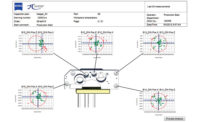More and more gage interfaces are designed for applications including automated test and measurement, data logging, temperature measurement and portable data acquisition. And, these interfaces are user friendly; they do not require taking apart the computer cabinet and installing additional circuit cards. They are more like power strips or extension cords that plug into an outlet and expand the number of electronic components that can be run at one time. Simply connecting a module through a plug-in connection into the back of a computer allows a host of peripherals to be plugged into the module and used.
One way to do this is with a universal serial bus (USB). A USB provides a high-speed link between measuring device and computer. It allows users to add peripherals, mix and match devices, and program when and how they are to be used, as well as what should be done with the collected data. The USB module connects to a port on a PC via a cable; most new computers have at least one, and often two, built-in USB ports. The PC automatically detects when a USB cable is plugged in so that hardwiring is not required.
The products on the market support the use of digital interfaces, probes, linear scales, proximity sensors, height gages, infrared switches and other test and inspection tools. These devices connect to the USB module directly through a port or through a hub. The data that is collected can be used in a go-no go scenario in an automated process or for data analysis using off-the-shelf or proprietary software.
Kurt Manufacturing (Minneapolis, MN) is one of the strongest proponents of USB technology. The company has invested heavily in the technology, developing modules for various applications that can be mixed and matched depending on the user's needs. It offers the KurtUSB Modular system, as well as individual USB components.
"It is our belief that all the peripherals that are run on a PC are going to be run by the USB," says Bryan Stout, an engineer and a marketing manager for Kurt Manufacturing. "Our belief is that because it is a standard platform it is going to continue to be developed. They have already come up with a second generation and it is going to become more efficient and more effective."
The modules developed by Kurt Manufacturing are small, each about the size of a typical paperback novel. The company calls the modules "building blocks" because they can be integrated together to replace large gaging systems, says Stout. Altogether, the KurtUSB modular system can support up to 220 devices and up to 800 inputs and outputs.
These blocks include a digital module for digital gages and hand tools, an LVDT module for linear variable differential transformer (LVDT) and analog applications, and a DC I/O (input/output) module for applications calling for push buttons, proximity sensors, valves, motors and photo eyes. These modules can be mixed and matched without requiring PLC logic, wiring and an enclosure. Five modules can be interfaced into a single KurtUSB base. The cost for a base module, including one license of the KurtSPC Data collection software, is $1,595. In addition, the company also offers the USB DigiDirect, a rugged, small footprint case that has four digital interfaces and at $595, can be used by small shops, for remote locations, or for field service work.
"From our standpoint, shrinking any product down has an advantage because we make SPC gaging systems and they take up real estate," says Stout. "If you can reduce the size of the real estate, the additional space can be used for other purposes such as manufacturing the product."
For instance, in an automotive setting, a variety of automated gages can be hooked up to a USB module and driven by the computer through the module. "In the automotive realm, one reject is one too many," says Stout. "Before, you would make a gage and put in a number of parts per hour and run your statistics. The new line of thought is that you make an automated gage and it sorts out good and bad parts. The gage then becomes a sorting system, auditing the product 100% and making sure that any nonspecified product gets kicked out. The USB supplies that control."
According to Stout, there are no design or fabrication costs for enclosures, terminal blocks, wiring, coding, PLC or PLC ladder logic programming. One software package, KurtSPC, controls the entire system and collects real-time SPC data for charting and data management.
For more information on the Kurt USB, contact:
Kurt Manufacturing Co.
2130 107th Lane N.E.
Minneapolis, MN 55449
(800) 343-9884
Fax: (763) 784-6055
URL: www.kurt.com
For more information on UDAS, contact:
Intelligent Instrumentation Inc.
2425 E. Medina Rd.
Tucson, AZ 85706
(800) 685-9911
Fax: (520) 573-9671
URL: www.instrument.com
Kurt is not the only company targeting USB products for the test, measurement and inspection market. Intelligent Instrumentation (Tucson, AZ), for instance, introduced a USB data acquisition system called UDAS, or USB Data Acquisition System. The UDAS can connect up to 127 systems to a single USB host and communicate with the PC simultaneously.
The company offers a number of UDAS models including the UDAS-100E-3 and -4 that have a built-in terminations so that entire data acquisition systems can be housed in a single enclosure. The cost for plug-and-play modules range from $895 to $1,060.
Other interface technology
USB is just one technology on the market that allows a multifunctional link to a PC. Here are a couple other products.
- MicroRidge (Sunriver, OR) offers MPX multiplexers that support the RS232 ProCable for connecting any serial device to the MPX. Multiple units can be chained with the expansion port. Two serial devices can be connected with the 2SP input module. The company also offers a wireless interface that has a 450-foot range in a noise-free environment.
- National Instruments (Austin, TX) offers an 18-slot PXI/Compact PCI chassis that can be rack mounted. With two PXI-to-PXI bridges, the backplane extends both the PXI bus and the timing and triggering signals to all 18-slots while maintaining the full 132 megabytes per second bandwidth defined by the PXI specification.
- Versatile Technology (Victoria, Australia) offers Dynamic Interface Measurement Modules (DIMM) that allows users to connect up to 32 modules in any order or combination and switch among them using the company's Intelliswitch Module. The modules can be joined in banks up to 3,000 feet from the PC. The system also features a re-tract drive head that automatically retracts or extends a probe tip between measurements.


